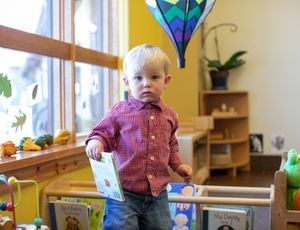Have you ever heard the term biophilia? This term was first used by Erich Fromm to describe the psychological orientation of being attracted to everything alive and vital. Humans have an innate subconscious attraction to nature. We can appreciate different shapes and colors of plants and animals. In a Montessori environment, there is a great emphasis on connecting nature with children. However, this is not reserved exclusively to Montessori schools; at home, children also need time to be with nature, to explore and have the freedom to make choices. There are many ways parents can provide opportunities in the environment for their children to enjoy nature.
Providing outdoor time to children has a significant impact on their physical and mental development. It allows them to get fresh air and explore the natural world in a hands-on way, but the benefits of it go much further; Dr. Maria Montessori always mentioned the importance of nature in the child’s life. If we look at many of the pictures taken of her with children, we notice that they are constantly outdoors on a terrace or a patio; nature was always a pillar in her philosophy.
Nowadays, nature tends to take second place in a child's life. In our generation, technology has become a big part of our society. It is not surprising to see children replacing outdoor time for hours watching TV, playing video games in front of a computer, or using a tablet. We tend to prefer human-made things, and gradually we are detaching ourselves from nature.
What are the Benefits Children get from being in Contact with Nature?
- Sensorial experiences: All five senses can be stimulated when a child spends time in contact with nature. Different textures, colors, smells, flavors, and sounds can be identified.
- Development of oral language: There is so much vocabulary the child will absorb when exposed to nature. Names of plants, colors, sizes, shapes, and verbs will be part of the conversation.
- Physical exercise: From children running and leaping in the backyard, to toddlers carrying a bucket with soil, everything is helping them to develop and refine their motor skills. There is a maximum effort when a toddler carries a big planter or fills up the watering can with water and takes it next to the plant.
- Outdoor and nature appreciation: When children are exposed to something, they start to appreciate it and identify the details.
Do you have to live near the woods to expose your child to nature?
No. Nature comes in many sizes, shapes, and colors. Here are some different examples of outdoor environments:
- Backyard at home: Some houses and apartments have a designated space for a garden.
- Balconies: Some houses do not have backyards but do have balconies; this can be an area where you can add flowers, herbs, bird feeders, a table for your toddler to enjoy the weather, and maybe even eat a snack outside.
- Parks: Every city has parks and many of them have playground structures for children to explore and enjoy. Some parks even have ponds, waterfalls, or botanical gardens.
- Greenhouses: These can be separated constructions with plenty of square footage, or it can be a small portable one inside the house.
- Designated indoor space: Houses and apartments that do not have direct access to the outside can still foster contact with nature. Bring small trees, plants, and herbs to the space (avoid plastic or fabric flowers). If you have any pets around the house, they are also part of nature.
It doesn't matter where you live; there is always a way to bring nature into your child’s everyday life.
Tips for outdoor time with your child
- Collect things like rocks, seeds, leaves, pinecones, twigs, etc.
- Bring paper and crayons to draw what you see: trees, water, flowers, squirrels, etc.
- Go for walks at a park, the beach, the woods or a botanical garden.
- Bring a magnifying glass to observe insects you find along your way.
- Plant a tree, flower, or seeds.
- Sit and watch the people walking around.
- Sit and close your eyes to hear the sounds of the outdoor environment.
Item of the Month
Paint and Plant Flower Growing Kit
Enjoy time with your toddler painting these pots and showing him how to plant seeds in each pot. You can talk about the different kinds of flowers he will be able to see grow with the appropriate care.
Link to buy it at Amazon: https://www.amazon.com/Dan-Darci-Paint-Flower-Growing/dp/B07KQLCGSR/ref=sr_1_2?dchild=1&keywords=Paint+and+Plant+Flower+Growing+Kit&qid=1594755947&sr=8-2
Quote of the Month
"Let the children be free; encourage them; let them run outside when it is raining; let them remove their shoes when they find a puddle of water; and, when the grass of the meadows is damp with dew, let them run on it and trample it with their bare feet...let them shout and laugh when the sun wakes them in the morning."
-Maria Montessori
Have some extra time?
Mother Nature’s Child: Growing Outdoors in the Media Age
Watch this 57 minute film that speaks about the relationship children have with nature and its importance in healthy human development. It is a delightful film that will inspire your creativity about how to include more nature in your child’s life.
Link to buy the DVD at Amazon:
https://www.amazon.com/Mother-Natures-Child-Growing-Outdoors/dp/0976447010
Book of the Month
Last Child in the Woods: Saving Our Children from Nature-Deficit Disorder by Richard Louv
This is a book rich in information about how the lack of nature in children’s lives is linked with attention disorders, obesity and depression. The author calls it the “nature-deficit” and offers practical solutions to it.
Link to buy it at Amazon:
https://www.amazon.com/Last-Child-Woods-Children-Nature-Deficit/dp/1565125223/ref=sr_1_2?keywords=last+child+in+the+woods&qid=1583987052&sr=8-2



